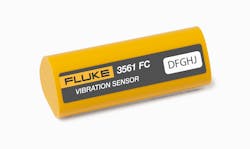Earlier this year I covered the release of Fluke’s 3560 FC wireless vibration sensor, which I referred to as a “stick-and-transmit” sensor due to the ease with which it can positioned and re-positioned by the user for various data collection applications. Fluke has now released an updated version of the sensor—the 3561 FC vibration sensor. Fluke notes that, like its predecessor, the 3561 FC sensor “allows maintenance teams to improve uptime by adding remote, continuous vibration monitoring to virtually any rotating equipment.”
One significant difference between the two models is its frequency range. Whereas the 3560 was capable of sensing in the 0-300 Hz range, the 3561 is capable of sensing in the 10-1000 Hz range. According to Frederic Baudart, lead product specialist at Fluke, the expanded range allows the sensor to predict four major equipment faults—imbalance, misalignment, looseness and bearing wear—and provide a warning of impending equipment failure due to these faults.
Vibration data from the 3561 FC is wirelessly transmitted via the Fluke 3502 FC Gateway to Fluke Connect Condition Monitoring (FCCM) software so that maintenance teams can remotely monitor asset health on a desktop or mobile device. FCCM software aggregates real-time and historical data from Fluke Connect-enabled tools and sensors for a comprehensive picture of equipment health that can help teams make better informed maintenance decisions. For more immediate response issues, the FCCM software generates automatic alarms when assets experience conditional changes outside the Fluke Overall Vibration Severity scale parameters, so that maintenance team members are notified before equipment issues become critical.
The 3561 FC’s affordability (pricing details below), according to Baudart, along with the ease with which it can be positioned on equipment or hard-to-reach locations, helps extend collection of sensor data beyond “Tier One” assets. For example, he noted that single-stage gearboxes are commonly used for material handling applications. Baudart said a typical distribution center can have hundreds of these gearboxes installed, and they won’t be considered Tier One assets. But when these gearboxes are used at key points of materials movement, their failure can cause a Tier One impact.
Baudart also noted that both Dana Corporation and Johnson & Johnson are current users of Fluke Connect and condition monitoring technologies to manage their equipment assets. Dana Corporation uses Fluke Connect, eMaint and Fluke Connect2Assets Automatic Meter Reading (AMR) integration and will soon begin using the 3561 FC sensor. Johnson & Johnson uses Fluke AMR, Mobile Enterprise Asset Management (EAM) and supervisory control and data acquisition (SCADA), and also plans to begin using the 3561 FC sensor.
The 3561 FC vibration sensors are sold as a kit (starting around $1,000), which includes four of the sensors each with 1- or 3-year Fluke Connect subscription, and a Fluke 3502 FC Gateway for transmitting the sensor data to the Fluke Connect app. According to Fluke, installation and setup of the kit is “simple, allowing technicians to start monitoring vibration on equipment in about an hour.”
In the release announcing the availability of the 3561 FC Vibration Sensor kit, Fluke highlighted the following aspects of its FCCM software:
- Helps maximize uptime and enables maintenance teams to make confident maintenance decisions with data that can be trusted and traced.
- Allows maintenance teams to access baseline, historical and current measurements by asset from virtually anywhere and at any time.
- Eliminates data-entry errors by saving measurements directly from tools and sensors and associating them with work orders, reports or asset records.
- Enables maintenance teams to move away from clipboards, notebooks and multiple spreadsheets with a wireless, one-step measurement transfer.
Leaders relevant to this article:


